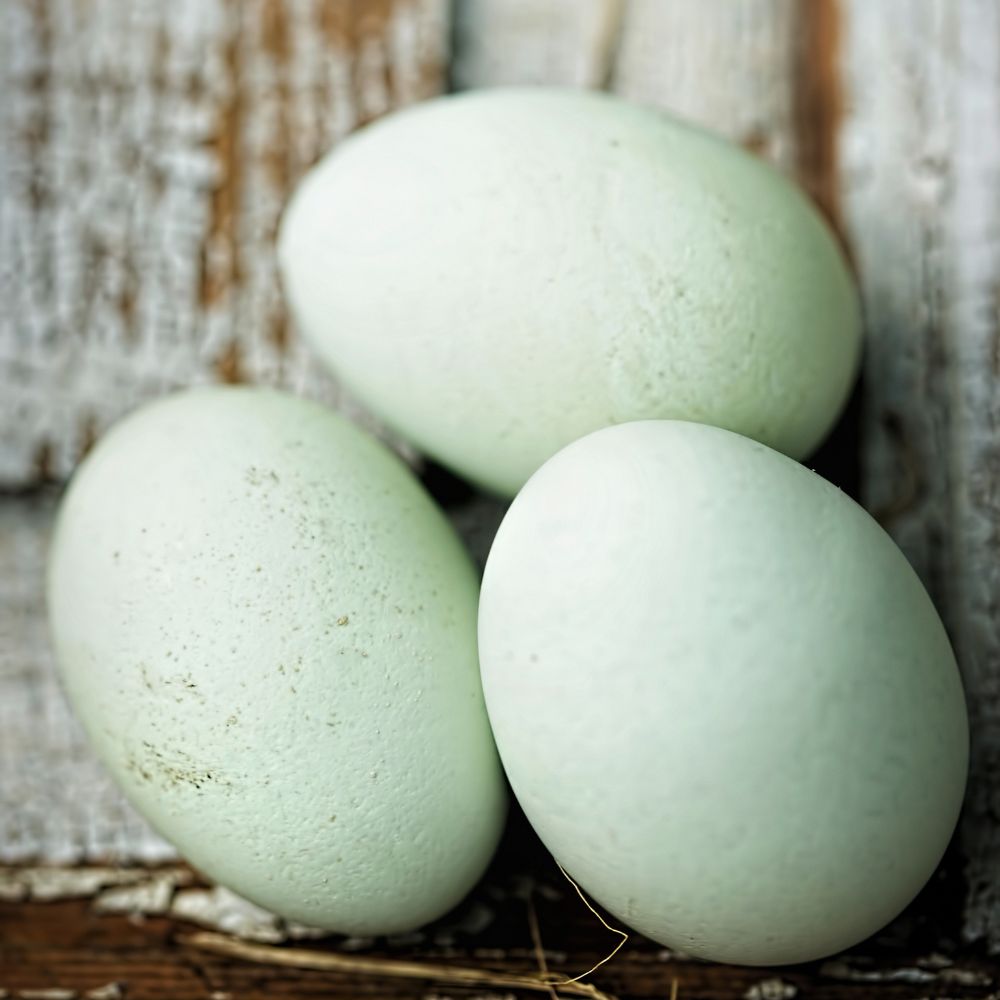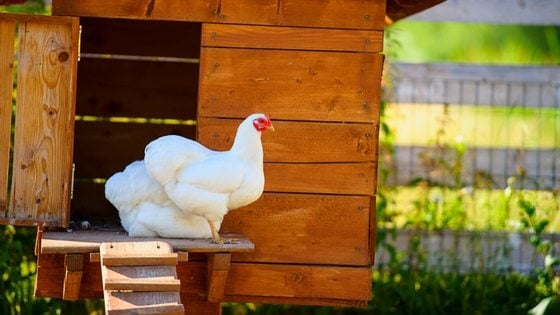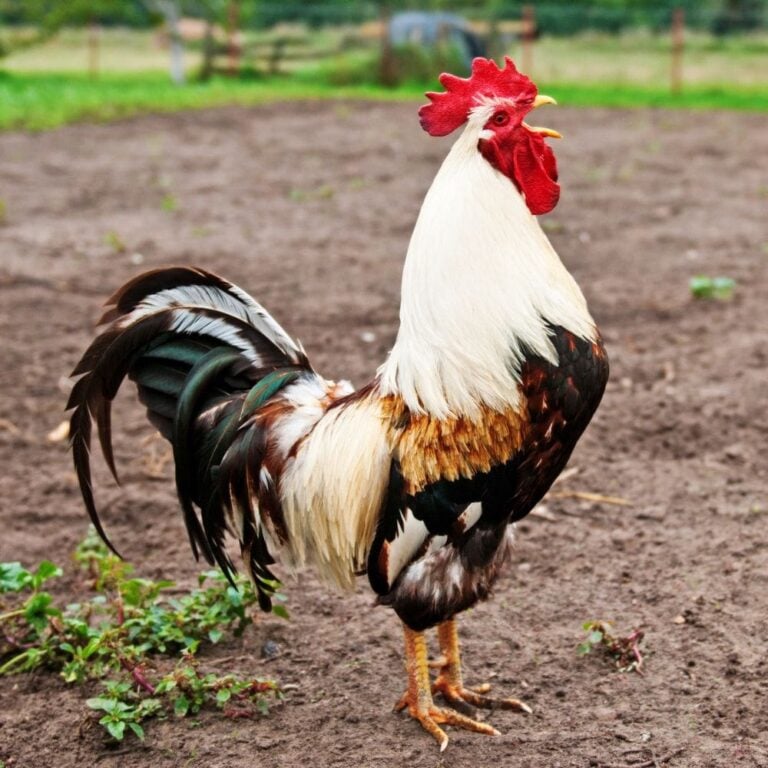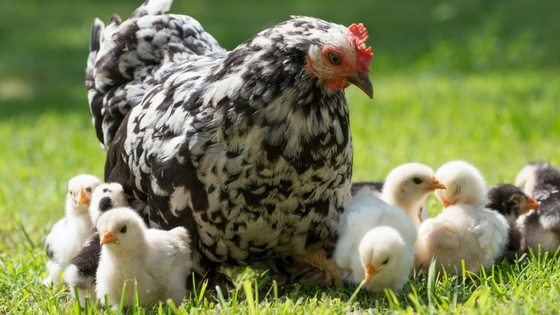Heard about chickens that lay blue eggs? Want one? Then you’re in for a treat – in this article, you’ll discover several chickens that pop out gorgeous, sky-colored eggs!
Surprisingly, there are quite a few types of chickens that lay blue eggs – and they’re all friendly and wonderful to look at.

Table of Contents (Quickly Jump To Information)
Why Are Some Chicken Eggs Blue?
Do you know WHY some backyard chickens lay blue eggs?
Turns out, it’s a genetic anomaly caused by a retrovirus between 200 and 500 years ago. Chicken breeds that lay blue eggs possess a gene called “callee oocyan” which is responsible for the coloration of the eggs.
And unlike other colors, blue penetrates the egg – so even the inside of the shell is blue! (If you crack open a brown egg, you’ll notice the inside of the eggshell is white – that’s because the brown doesn’t penetrate the shell).
If it’s caused by a virus, does that mean the chickens are sick? No, it doesn’t – it just means a virus caused a genetic mutation that lead to blue eggs. And now we get to benefit.
Another common question is whether blue eggs are genetically modified. No, they’re definitely not! They’re completely natural!
How do you know what shade of blue the egg will be? A light blue or a dark blue, or in between? The color of the egg depends on the individual hen and there’s no good way to know until they start laying.
5 Kinds Of Chicken That Lay Blue Eggs
Although each of these 5 types of chickens lays blue eggs, just understand that the shade of blue might vary. Some might be a pale blue, while others might lay striking sky-blue eggs.
Ameraucana
Want chickens that lay blue eggs? Why not an Ameraucana?
Ameraucana is truly an American breed – as their name implies! The name Ameraucana is a cross between “America” and “Araucana.” (More on Araucanas below)
Agricultural scientists developed this breed, hoping to preserve the blue-egg laying genes of the Araucana chicken – but also to eliminate its lethal gene that can kill the chick before it hatches. Here is an excellent article on Araucana’s: Araucana Chickens – Extremely Rare Breed Worth Checking Out
Through trial and error, scientists created these beautiful grey-blue feathered hens. In the 1980s, they were formally recognized by APA and American Bantam Association (ABA).
Even though they look unique, Ameraucanas are easily confused with other chickens that lay blue eggs – the Araucana chicken and Easter Eggers.
For those who don’t know the difference, it’s so confusing that you’ll find even hatcheries sometimes mislabel these birds.
Ameraucana chickens have beautifully curved beaks, large eyes, and a red “pea” comb. This pea comb, together with the wattles and the round earlobes, should be red. Ameraucana chickens also appear to have a “beard of feathers” and adorable muffs that sometimes almost cover their face.
They’re consistent egg layers that produce about 200 blue eggs a year – pretty good statistics! Ameraucana eggs can be light blue to almost green to sky blue – it just depends on the individual hen.
You can learn more about Ameraucanas here.
Araucana Chickens
Araucanas are wonderful chickens, and truly a unique, ancient breed. They’re also the foundation of every blue egg-laying breed out there!
This breed is native to Chile, and is named after the Araucania region of Chile.
These chickens have a very unique appearance. Like Ameraucana and Easter eggers, they have “peduncles” – tufts of feathers that develop near their ears that they’re born with.
Some can have tufts so pronounced, they look like handlebar mustaches!
Araucanas don’t have tail bones like most chicken breeds, so they won’t grow any long, fabulous tail feathers. It gives them a distinctive profile that can differ from Ameraucanas and Easter Eggers.
Like Brahma chickens and Silkies, Araucanas are born with small pea combs, which makes them ideal for colder climates. It’s less likely they’ll develop frostbite!
Adult males weigh about 5 pounds while hens lay about 4 pounds, making them one of the smaller breeds of chickens.
Just remember that if you plan to buy these blue egg layers, they should be recognized colors, exhibit the tufts, and be rumpless. You can use these characteristics to be sure the chickens you’re buying are truly chickens that lay blue eggs.
You can read more about Araucana chickens here.
Easter Eggers
Unlike Ameraucana, Easter eggers are hybrids (meaning, they’re not a recognized standard breed). This variety is, usually a mix between Ameraucana or Araucana chickens and a brown egg layer, such as a Rhode Island Red.
In other words, Easter Egger chickens can be of any lineage, as long as at least one parent has the blue egg-laying gene.
While some do lay blue eggs, because of their mixed heritage, not all will. Easter Egger eggs can be blue, brown, green, or even pink – a rainbow of egg colors certain to brighten any basket!
Also, they do not breed true, so even if you breed 2 Easter Egger chickens together, there’s no telling what characteristics the offspring will have. No two Easter Eggers look exactly the same.
They make wonderful pets (I own quite a few) but if you want blue eggs, it’s best to consider an Araucana or Ameraucana.
You can learn more about Easter Egger Chickens here.
Cream Legbar
Cream Legbars are a breed developed in the 20th century by researchers at Cambridge University by crossing a heritage breed like Barred Plymouth Rocks, Leghorns, Cambars, and Araucanas. They’re medium-sized birds, with cream-colored feathers. The hens aren’t very broody – so egg collecting should be easy!
They have adorable tufts of feathers on their heads – so they’re a sure show-stopper!
This variety lays about 200 blue or blue-green eggs each year.
Arkansas Blue
This variety was developed in Arkansas (hence its name) at the University of Arkansas-Fayetteville.
Although derived from Araucana bloodlines, these chickens don’t have muffs, tufts, or beards. They do have the pea comb, however. While still a new breed that’s not recognized, the chickens do lay blue eggs.
Blue Chicken Egg FAQ
How Do You Tell What Color Eggs A Chicken Will Lay?
In short, when it comes to chickens that lay blue eggs, you can’t really tell what color eggs they’ll lay unless your hens are purebred Araucana, Ameraucanas, or Cream Legbars.
In a general sense, though, brown egg layers have red earlobes. However, you’ll likely notice that Easter Eggers, Ameraucanas, Araucanas, and even olive Eggers have red earlobes!
So, the easiest way to tell what color eggs a chicken lays is to either purchase purebred hens OR wait and see what pops out!
Do Blue Chicken Eggs Taste Different?
NO! They taste just like any other egg (maybe even better if your hens have an organic diet with herbs included!). And they’re just as healthy! In fact, the nutritional quality of an egg depends completely on the health of the hen and her diet.
It’s a common misconception to think that eggs of different colors taste will taste weird, however. Eggs generally do not taste different when the hens eat the same chicken feed and live under the same conditions.
If you want to make sure all your chickens eat the same diet, you can read our review of chicken feeders here. There are several automatic feeders that make it easy to track how much your flock is eating.
You can read more about what to feed a chicken for great-tasting eggs here.
Are Blue Chicken Eggs Safe Or Edible?
Yes! The color of the eggs doesn’t make them taste any different as long as the hens are fed the same consistent diet.
The color of the egg just affects the look of the eggshell – not the nutritional value. Chickens that lay blue eggs – like every other chicken – should have a diet that includes a high-quality layer feed to ensure the highest quality yolks.
Are Blue Eggs Better For You?
While some health food proponents claim that blue eggs contain less cholesterol than regular white or brown eggs, it has been proven false by scientific data. The color of the egg doesn’t affect its quality. However, the quality of the feed does.
Summary
If you want to add some more fun to your barnyard recipe, then why not try getting chickens that lay blue eggs? I find so much enjoyment in finding different colored eggs in my coop, and my kids especially like it. As with any chickens, just be sure you are getting them from a reputable hatchery or breeder so your experience turns out to be a good one!
Maat van Uitert is a backyard chicken and sustainable living expert. She is also the author of Chickens: Naturally Raising A Sustainable Flock, which was a best seller in it’s Amazon category. Maat has been featured on NBC, CBS, AOL Finance, Community Chickens, the Huffington Post, Chickens magazine, Backyard Poultry, and Countryside Magazine. She lives on her farm in Southeast Missouri with her husband, two children, and about a million chickens and ducks. You can follow Maat on Facebook here and Instagram here.

![Help Chicks Transform Into Healthy Pullets With These Pro Tips [Podcast]](https://thefrugalchicken.com/wp-content/uploads/2016/05/chicks-turning-into-pullets-min.jpg)
![Real Homesteader Stories Episode 5!: The Ditch That’ll Save Us All, Broody Hens, & Duckling Update! [Video]](https://thefrugalchicken.com/wp-content/uploads/2017/05/Real-Homesteader-Stories-episode-5.jpg)

![You CAN Raise Meat Chickens (And Actually Go Through With It!) [Podcast]](https://thefrugalchicken.com/wp-content/uploads/2016/01/raise-meat-chickens-feature-min.jpg)


Absolutely great information. I have been entertaining getting a blue egg layer.
Go for it! All the breeds I mentioned are really friendly.